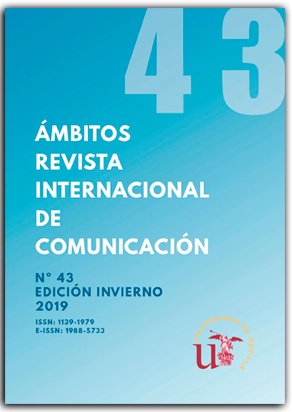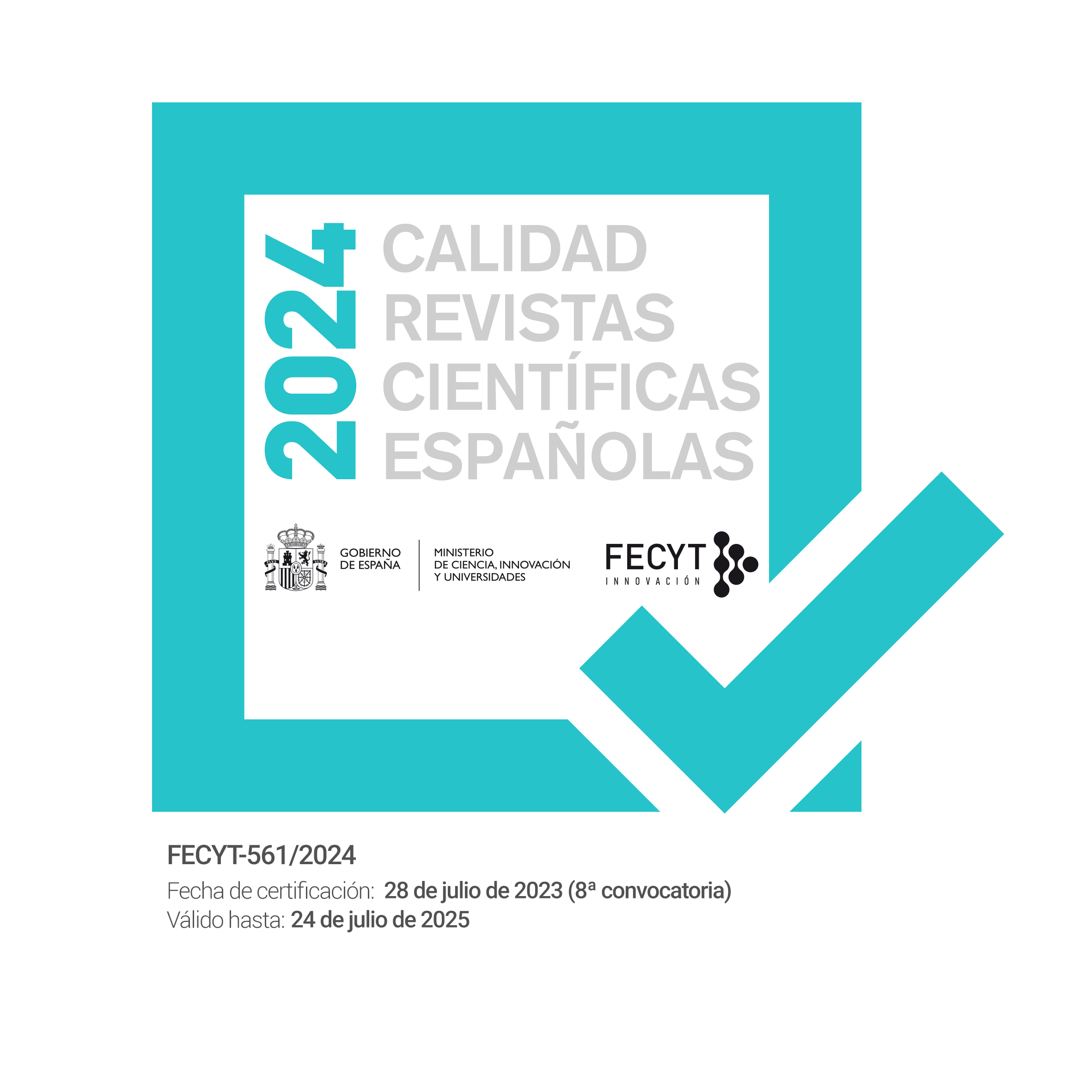Periodismo de confirmación vs. Desinformación: Verificado18 y las elecciones mexicanas de 2018
DOI:
https://doi.org/10.12795/Ambitos.2019.i43.05Palabras clave:
Noticias falsas, Desinformación, Periodismo de comprobación, Elecciones mexicanas, Verificado18, Fake News, Disinformation, Fact-Checking, Mexico’s ElectionsResumen
Resumen: La proliferación de noticias falsas en redes sociales constituye un desafío no sólo para el mundo del periodismo, sino también para nuestras democracias. Este hecho es especialmente controvertido si tenemos en cuenta que estas herramientas se han convertido en una popular fuente informativa, toda vez que los medios de comunicación tradicionales han perdido su supremacía a la hora de seleccionar contenidos noticiables. Como consecuencia, los ciudadanos están expuestos a informaciones sesgadas que promueven la desinformación. Particularmente ilustrativo, es el papel desempeñado por Facebook y Twitter en la divulgación de afirmaciones falsas de políticos durante varias de las campañas electorales de los últimos años. Empero, fue el flujo de desinformación surgido durante las elecciones presidenciales estadounidenses de 2016 el detonante que alimentó el interés en chequear todos aquellos contenidos distribuidos a través de Internet. En este contexto, el objetivo de la investigación es analizar el trabajo desarrollado por las iniciativas de periodismo de comprobación de datos, centrándonos en el caso de Verificado18: un proyecto colaborativo iniciado en México en 2018, de cara a las elecciones más multitudinarias del país, y destinado a identificar promesas falsas y contenidos manipulados. Para ello, realizamos un abordaje tanto cuantitativo como cualitativo de los datos extraídos de la Web verificado.mx. Al hacerlo, arrojaremos luz sobre aspectos como: la metodología utilizada, las temáticas cubiertas, los actores involucrados y las herramientas interactivas implementadas. Los hallazgos sugieren que, a pesar de su potencial educativo, es pertinente mejorar aspectos como la transparencia.
Abstract:The increase in the number of fake news on Social Network Sites (SNS) form a serious threat not only to journalism, but also to our democracies. This is not a minor issue, given that SNS has become into a popular source of information, whilst, at the same time, traditional media are declining in their gatekeeping role. As a result, citizens are exposed to biased news that led to disinformation. An illustrative example is the role played by Facebook and Twitter in spreading false or outrageous statements by politicians during some of the latest political campaigns. Nonetheless, it was the flow of disinformation around the 2016 US presidential election that spurred intense interest in fact-checking what is spread online. In this context, the aim of this paper is to analyse the work undertaken by fact-checking outlets, by focusing on Verificado18: a collaborative project launched in 2018 ahead of Mexico’s largest election, to identify untrue statements from politicians and check content authenticity. To fulfil this purpose, we provide this analysis on the basis of a mix of qualitative and quantitative data from verificado.mx. In doing so, we throw light on the methodology used to debunk disinformation, the topics most commonly covered, the actors involved, and the interactive tools implemented. Our findings suggest that, in spite of its educative potential, more efforts needs to be done as far as transparency is concerned.
Descargas
Métricas
Citas
Allcott, H., Gentzkow, M. (2017). Social Media and Fake News in the 2016 Election. Journal of Economic Perspectives 31 (2), 211-236.
Anderson, M., Caumont, A. (2014 October 11). How social media is reshaping news. Pew Research Center. Retrieved from http://www.pewresearch.org/fact-tank/2014/09/24/how-social-media-is-reshaping-news/
Así funciona #Verificado2018 – Metodología (12 de marzo de 2018) Verificado18 Recuperado de: https://verificado.mx/metodologia/
Danzig, J. (2017 November 15). European Union or a new Soviet Union? Retreived from: https://goo.gl/8e3xkw
European Commission (2018) A multi-dimensional approach to disinformation: Final report of the High Level Expert Group on Fake News and Online Disinformation. Luxembourg: European Union. Retreived from:https://goo.gl/bk9NYg
Gallant N.; Latzo-Toth, G.; Pastinelli M. (2015). Circulation de l’Information sur les Médias Sociaux pendant la Grève Étudiante de 2012 au Québec. Centre d’Étude des Médias. Retreived from: http://www.cem.ulaval.ca/pdf/CirculationInformation.pdf.
Graves, L. (2018). Boundaries Not Drawn: Mapping the institutional roots of the global fact-checking movement.Journalism Studies 19(5), 613-631.
Graves, L. & Cherubini, F. (2016). The rise of fact-checking sites in Europe. Reuters Institute Digital News Report. Retreived from https://ora.ox.ac.uk/objects/uuid:d55ef650-e351-4526-b942-6c9e00129ad7
Gentzkow, M., Jesse M. S.; Daniel F. S., (2016) Media Bias in the Marketplace: Theory. In Anderson, S., Waldofgel, J., & Stromberg D., (ed.) Handbook of Media Economics, vol. 1B,
Gottfried J.; Shearer, E. (2016 April 26). News Use Across Social Media Platforms 2016. Pew Research Center. Retreived from goo.gl/WHEzOP.
Goel, V. (2018 May 14). In India, Facebook’s WhatsApp Plays Central Role in Elections. The New York Times. Retreived from: https://www.nytimes.com/2018/05/14/technology/whatsapp-india-elections.html
Hazard Owen, L (2018). WhatsApp is a black box for fake news. Verificado 2018 is making real progress fixing that. Nieman Lab. Retreived from: http://www.niemanlab.org/2018/06/whatsapp-is-a-black-box-for-fake-news-verificado-2018-is-making-real-progress-fixing-that/
ICA (2017 January). Background to “Assessing Russian Activities and Intentions in Recent US Elections”: The Analytic Process and Cyber Incident Attribution. Retrieved from: https://www.dni.gov/files/documents/ICA_2017_01.pdf
Jungherr, A. (2015). Analyzing political communication with digital trace data. Switzerland: Springer. (https://goo.gl/8CWHZs).
Khatib, D.; Larrea Maccise, D. (12 de marzo, 2018). ¡Bienvenid@s a #Verificado2018! Verificado18. Recuperado de https://verificado.mx/bienvenidos-a-verificado-2018/
Lotero-Echeverri, G.; Romero-Rodríguez, L. M.; Pérez-Rodríguez, M. A. (2018). Fact-checking vs. Fake news: Periodismo de confirmación como recurso de la competencia mediática contra la desinformación. index.comunicación, 8(2), 295-316.
Mathieu, D., (2015). The Continued Relevance of Reception Analysis in the Age of Social Media. Trípodos, 36, 13-34.
Najar, A. (1 julio 2018) 5 razones que hacen históricas las elecciones presidenciales en México. BBC Mundo. Recuperado de https://www.bbc.com/mundo/noticias-america-latina-43578377
Palau-Sampio, D. (2018). Fact-checking and scrutiny of power: Supervision of public discourses in new media platforms from Latin America. Communication & Society 31(3), 347-363.
Palau-Sampio, D. (2016). Metamorfosis de la prensa de referencia en el contexto digital: clickbait y estrategias de tabloide en Elpais.com. Comunicación y Sociedad, 29(2), 63-80. Doi: http://doi.org/10.15581/003.29.2.sp.63-80
Panetta, K., (2017 October 3). From bots and AI to counterfeit reality and fake news, these predictions require IT leaders to pace their adoption. Gartner Top Strategic Kasey Panetta: Predictions for 2018 and Beyond. Retreived from https://goo.gl/cSbNp7
Restrepo, H. (2017). Clickbait: por qué está mal. Ética segura: red de ética y periodismo. Recuperado de https://goo.gl/KhvPOy
Shin, J.; Jian, L.; Driscoll, K.; Bar, F. (2018). The diffusion of misinformation on social media: Temporal pattern, message, and source. Computers in Human Behavior, 83, 278–287. Doi: https://doi.org/10.1016/j.chb.2018.02.008
Silverman, C. (2016 November 16). This Analysis Shows how Fake Election News Stories Outperformed Real News on Facebook. Retrieved from https://goo.gl/qv6nQO
Stencel, M.; Griffin, Riley (2018 February 22). Fact-checking triples over four years. Duke Reporters’ Lab.. Retreived from: https://reporterslab.org/the-number-of-fact-checkers-around-the-world-156-and-growing/
Subramanian, S., (2017 February 15). Inside the Macedonian Fake-News Complex. Retrieved from https://goo.gl/fsskzC
Sydell, L. (2016 November 23). We Tracked Down a Fake-News Creator in the Suburbs. Here’s What We Learned. Retrieved fromhttps://goo.gl/hN5pZ8
Tesich, S. (1992 January 1). A Government of Lies. The Nation. Retrieved from https://goo.gl/dzEZqi
Townsend, T., (2016 November 22). Meet the Romanian Trump Fan behind a Major Fake News Site. Retrieved from http://www. inc.com/tess-townsend/ending-fedtrump-facebook.html.
Tufekci, Z., (2015 July 5). How Facebook’s Algorithm Suppresses Content Diversity (Modestly) and How the Newsfeed Rules Your Clicks. Retrieved from goo.gl/Ql1XEd
Viner, K. (2016 July 12). How technology disrupted the truth. Retrieved from goo.gl/gIqGWM.
Descargas
Publicado
Cómo citar
Número
Sección
Licencia
Ámbitos. Revista Internacional de Comunicación es una revista de acceso abierto, lo que significa que todo su contenido está disponible gratuitamente para el usuario o su institución. Los usuarios pueden leer, descargar, copiar, distribuir, imprimir, buscar o enlazar con el texto completo de los artículos, o utilizarlos para cualquier otro fin lícito, sin solicitar permiso previo al editor o al autor. Esta definición de acceso abierto se ajusta a la Iniciativa de Acceso Abierto de Budapest (BOAI).

A menos que se indique lo contrario, todo el contenido de la edición electrónica se distribuye bajo una " licencia internacional Creative Commons Attribution-NonCommercial-ShareAlike 4.0 ". Puede consultar la versión informativa y el texto legal de la licencia aquí. Esto debe indicarse expresamente de esta manera cuando sea necesario.
En caso de aceptación del manuscrito, los autores ceden los derechos de la obra para su publicación a Ámbitos. Revista Internacional de Comunicación bajo el contrato de licencia Reconocimiento-NoComercial-CompartirIgual 4.0 Internacional (CC BY-NC-SA 4.0). Los autores conservan los derechos de autor y terceros están autorizados a copiar, distribuir y hacer uso de la obra, siempre que cumplan con los términos y condiciones establecidos en la licencia.
- Citar la autoría y la fuente original de publicación (revista, editorial y URL de la obra).
- No los utilice con fines comerciales.
- Si remezcla, transforma o crea a partir del material, debe publicar sus contribuciones bajo la misma licencia que el original.
Se puede encontrar más información en https://creativecommons.org/licenses/by-nc-sa/4.0/deed.es
- Resumen 658
- PDF 411



















